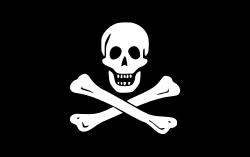海盗旗
| 此条目翻译品质不佳。 (2022年3月31日) |

海盗旗(英语:Jolly Roger)是 18 世纪早期(海盗黄金时代后期),一些海盗船在发动袭击前会升起的一类旗帜。
今天最常见的标志是海盗旗—黑旗上的骷髅和交叉骨符号—在 1710 年代被许多海盗船长使用,包括塞缪尔·贝拉米、爱德华·英格兰和约翰·泰勒(John Taylor)。 它继续成为 1720 年代最常用的海盗旗,尽管其他设计也被使用。
实际运用状况[编辑]
这种旗帜可能是为了传达海盗的身份,这可能让目标船只有机会决定不战而降。例如,1720 年 6 月,当巴塞洛缪·罗伯茨 (Bartholomew Roberts) 飘扬黑旗驶入纽芬兰特雷帕西 (Trepassey) 港时,港内所有 22 艘船只的船员都惊慌失措地弃船。[1]
使用该种旗帜是证明自己是海盗的可靠方式。仅仅拥有或使用该种旗帜就被认为是证明一个人是犯罪海盗而不是更合法的东西;只有海盗才敢使用该种旗帜,因为他已经面临被处决的威胁。[2]
相关条目[编辑]
| 维基共享资源上的相关多媒体资源:海盗旗 |
- 美国海军第84战斗攻击中队 - 以海盗旗作为队徽而著名,于1995年10月1日解编
- 美国海军第103战斗攻击中队 - 上叙的VF-84中队解编后,接续使用海盗旗作为队徽
参考资料[编辑]
- ^ Burl, Aubery. Black Bart. : 133–34.
- ^ Leeson, Peter T. Pirational Choice: The Economics of Infamous Pirate Practices (PDF). 2008: 12 [2022-01-04]. (原始内容存档 (PDF)于2011-07-15). "Ships attacking under the death head's toothy grin were therefore considered criminal and could be prosecuted as pirates. Since pirates were criminals anyway, for them, flying the Jolly Roger was costless. If they were captured and found guilty, the penalty they faced was the same whether they used the Jolly Roger in taking merchant ships or not – the hangman's noose... For legitimate ships, however, things were different. To retain at least a veneer of legitimacy, privateers and Spanish coast guard ships could not sail under pirate colours. If they did, they could be hunted and hanged as pirates."
